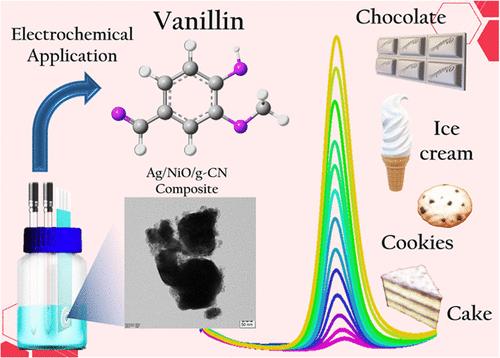Surfactant-Assisted Synthesis of Metallic-Ag/Nickel Oxide on Graphitic Carbon Nitride Composite: An Electrochemical Investigation of Synthetic Vanillin
IF 8.2
2区 材料科学
Q1 MATERIALS SCIENCE, MULTIDISCIPLINARY
引用次数: 0
Abstract
In this study, we developed a sensor based on surfactant-assisted synthesis of metallic silver-enriched nickel oxide confined on graphitic carbon nitride (Ag/NiO/g-CN)-modified electrode to construct a sensitive and selective voltammetric sensor for detecting vanillin in confectionaries samples. The X-ray diffraction (XRD) and Fourier transform infrared (FT-IR) spectroscopy analyses confirmed the crystal structure and respective functional groups of the synthesized Ag/NiO/g-CN composite. The valence states of silver, nickel, oxygen, carbon, and nitrogen were analyzed using X-ray photoelectron spectroscopy (XPS), while energy-dispersive X-ray analysis (EDX) and morphological investigations revealed the elemental distribution and nano-structured particles, respectively. The electrocatalyst-modified electrode properties and electrochemical sensing performances were evaluated using different voltammetric and spectroscopic techniques. The Ag/NiO/g-CN composite, exhibiting a large active surface area, excellent conductivity, and synergistic interaction, proved to be a suitable electrode material for electrochemical sensor applications. The sensor demonstrated a detection limit of 0.9 nM and a broad linear range of 0.004–366.8 μM. Electrochemical investigations further highlighted the sensor’s excellent reproducibility, repeatability, fast response, and functional stability. The constructed sensor also exhibited outstanding selectivity against potential interferents and demonstrated its practical applicability by successfully detecting vanillin in spiked food samples.

表面活性剂在石墨氮化碳复合材料上辅助合成金属银/氧化镍:合成香兰素的电化学研究
在本研究中,我们开发了一种基于表面活性剂辅助合成的石墨化碳氮化碳(Ag/NiO/g-CN)修饰电极上金属富银氧化镍的传感器,构建了一种灵敏、选择性的伏安传感器,用于检测糖果样品中的香兰素。x射线衍射(XRD)和傅里叶变换红外光谱(FT-IR)分析证实了合成的Ag/NiO/g-CN复合材料的晶体结构和各自的官能团。利用x射线光电子能谱(XPS)分析了银、镍、氧、碳和氮的价态,并用能量色散x射线分析(EDX)和形态研究分别揭示了元素分布和纳米结构颗粒。采用不同的伏安和光谱技术对电催化剂修饰电极的性能和电化学传感性能进行了评价。Ag/NiO/g-CN复合材料具有较大的活性表面积、优异的导电性和协同作用,是一种适合电化学传感器应用的电极材料。该传感器的检测限为0.9 nM,线性范围为0.004 ~ 366.8 μM。电化学研究进一步强调了该传感器优异的再现性、可重复性、快速响应和功能稳定性。所构建的传感器对潜在干扰物也表现出出色的选择性,并通过成功检测加标食品样品中的香兰素证明了其实用性。
本文章由计算机程序翻译,如有差异,请以英文原文为准。
求助全文
约1分钟内获得全文
求助全文
来源期刊

ACS Applied Materials & Interfaces
工程技术-材料科学:综合
CiteScore
16.00
自引率
6.30%
发文量
4978
审稿时长
1.8 months
期刊介绍:
ACS Applied Materials & Interfaces is a leading interdisciplinary journal that brings together chemists, engineers, physicists, and biologists to explore the development and utilization of newly-discovered materials and interfacial processes for specific applications. Our journal has experienced remarkable growth since its establishment in 2009, both in terms of the number of articles published and the impact of the research showcased. We are proud to foster a truly global community, with the majority of published articles originating from outside the United States, reflecting the rapid growth of applied research worldwide.
 求助内容:
求助内容: 应助结果提醒方式:
应助结果提醒方式:


